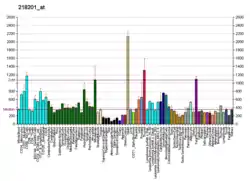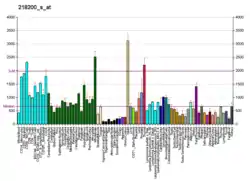NDUFB2
NADH dehydrogenase [ubiquinone] 1 beta subcomplex subunit 2, mitochondrial is an enzyme that in humans is encoded by the NDUFB2 gene.[4][5][6] NADH dehydrogenase (ubiquinone) 1 beta subcomplex, 2, 8kDa is an accessory subunit of the NADH dehydrogenase (ubiquinone) complex, located in the mitochondrial inner membrane. It is also known as Complex I and is the largest of the five complexes of the electron transport chain.[7]
| NDUFB2 | |||||||||||||||||||||||||
|---|---|---|---|---|---|---|---|---|---|---|---|---|---|---|---|---|---|---|---|---|---|---|---|---|---|
| Identifiers | |||||||||||||||||||||||||
| Aliases | NDUFB2, AGGG, CI-AGGG, NADH:ubiquinone oxidoreductase subunit B2 | ||||||||||||||||||||||||
| External IDs | OMIM: 603838 MGI: 1915448 HomoloGene: 3341 GeneCards: NDUFB2 | ||||||||||||||||||||||||
| |||||||||||||||||||||||||
| |||||||||||||||||||||||||
| |||||||||||||||||||||||||
| Orthologs | |||||||||||||||||||||||||
| Species | Human | Mouse | |||||||||||||||||||||||
| Entrez | |||||||||||||||||||||||||
| Ensembl | |||||||||||||||||||||||||
| UniProt | |||||||||||||||||||||||||
| RefSeq (mRNA) | |||||||||||||||||||||||||
| RefSeq (protein) | |||||||||||||||||||||||||
| Location (UCSC) | Chr 7: 140.69 – 140.72 Mb | n/a | |||||||||||||||||||||||
| PubMed search | [2] | [3] | |||||||||||||||||||||||
| Wikidata | |||||||||||||||||||||||||
| |||||||||||||||||||||||||
Structure
The NDUFB2 gene, located on the q arm of chromosome 7 in position 34, is 9,966 base pairs long and is composed of 4 exons.[6] The NDUFB2 protein weighs 12 kDa and is composed of 105 amino acids.[8][9] NDUFB2 is a subunit of the enzyme NADH dehydrogenase (ubiquinone), the largest of the respiratory complexes. The structure is L-shaped with a long, hydrophobic transmembrane domain and a hydrophilic domain for the peripheral arm that includes all the known redox centers and the NADH binding site.[7] NDUFB3 is one of about 31 hydrophobic subunits that form the transmembrane region of Complex I. It has been noted that the N-terminal hydrophobic domain has the potential to be folded into an alpha helix spanning the inner mitochondrial membrane with a C-terminal hydrophilic domain interacting with globular subunits of Complex I. The highly conserved two-domain structure suggests that this feature is critical for the protein function and that the hydrophobic domain acts as an anchor for the NADH dehydrogenase (ubiquinone) complex at the inner mitochondrial membrane. Hydropathy analysis revealed that this subunit and 4 other subunits have an overall hydrophilic pattern, even though they are found within the hydrophobic protein (HP) fraction of complex I.[6]
Function
The human NDUFB2 gene codes for a subunit of Complex I of the respiratory chain, which transfers electrons from NADH to ubiquinone.[6] However, NDUFB2 is an accessory subunit of the complex that is believed not to be involved in catalysis.[10] Initially, NADH binds to Complex I and transfers two electrons to the isoalloxazine ring of the flavin mononucleotide (FMN) prosthetic arm to form FMNH2. The electrons are transferred through a series of iron-sulfur (Fe-S) clusters in the prosthetic arm and finally to coenzyme Q10 (CoQ), which is reduced to ubiquinol (CoQH2). The flow of electrons changes the redox state of the protein, resulting in a conformational change and pK shift of the ionizable side chain, which pumps four hydrogen ions out of the mitochondrial matrix.[7]
References
- GRCh38: Ensembl release 89: ENSG00000090266 - Ensembl, May 2017
- "Human PubMed Reference:". National Center for Biotechnology Information, U.S. National Library of Medicine.
- "Mouse PubMed Reference:". National Center for Biotechnology Information, U.S. National Library of Medicine.
- Emahazion T, Beskow A, Gyllensten U, Brookes AJ (Nov 1998). "Intron based radiation hybrid mapping of 15 complex I genes of the human electron transport chain". Cytogenet Cell Genet. 82 (1–2): 115–9. doi:10.1159/000015082. PMID 9763677. S2CID 46818955.
- Loeffen JL, Triepels RH, van den Heuvel LP, Schuelke M, Buskens CA, Smeets RJ, Trijbels JM, Smeitink JA (Jan 1999). "cDNA of eight nuclear encoded subunits of NADH:ubiquinone oxidoreductase: human complex I cDNA characterization completed". Biochem Biophys Res Commun. 253 (2): 415–22. doi:10.1006/bbrc.1998.9786. PMID 9878551.
- "Entrez Gene: NDUFB2 NADH dehydrogenase (ubiquinone) 1 beta subcomplex, 2, 8kDa".
- Voet D, Voet JG, Pratt CW (2013). "Chapter 18". Fundamentals of biochemistry: life at the molecular level (4th ed.). Hoboken, NJ: Wiley. pp. 581–620. ISBN 978-0-470-54784-7.
- Zong NC, Li H, Li H, Lam MP, Jimenez RC, Kim CS, Deng N, Kim AK, Choi JH, Zelaya I, Liem D, Meyer D, Odeberg J, Fang C, Lu HJ, Xu T, Weiss J, Duan H, Uhlen M, Yates JR, Apweiler R, Ge J, Hermjakob H, Ping P (Oct 2013). "Integration of cardiac proteome biology and medicine by a specialized knowledgebase". Circulation Research. 113 (9): 1043–53. doi:10.1161/CIRCRESAHA.113.301151. PMC 4076475. PMID 23965338.
- "NADH dehydrogenase [ubiquinone] 1 beta subcomplex subunit 1". Cardiac Organellar Protein Atlas Knowledgebase (COPaKB).
- "NDUFB2 - NADH dehydrogenase [ubiquinone] 1 beta subcomplex subunit 2". UniProt: a hub for protein information. The UniProt Consortium. Retrieved 2 April 2015.
Further reading
- Gerhard DS, Wagner L, Feingold EA, et al. (2004). "The status, quality, and expansion of the NIH full-length cDNA project: the Mammalian Gene Collection (MGC)". Genome Res. 14 (10B): 2121–7. doi:10.1101/gr.2596504. PMC 528928. PMID 15489334.
- Yeh CH, Pang JH, Wu YC, et al. (2004). "Differential-display polymerase chain reaction identifies nicotinamide adenine dinucleotide-ubiquinone oxidoreductase as an ischemia/reperfusion-regulated gene in cardiomyocytes". Chest. 125 (1): 228–35. doi:10.1378/chest.125.1.228. PMID 14718445.
- Scherer SW, Cheung J, MacDonald JR, et al. (2003). "Human chromosome 7: DNA sequence and biology". Science. 300 (5620): 767–72. Bibcode:2003Sci...300..767S. doi:10.1126/science.1083423. PMC 2882961. PMID 12690205.
- Strausberg RL, Feingold EA, Grouse LH, et al. (2003). "Generation and initial analysis of more than 15,000 full-length human and mouse cDNA sequences". Proc. Natl. Acad. Sci. U.S.A. 99 (26): 16899–903. Bibcode:2002PNAS...9916899M. doi:10.1073/pnas.242603899. PMC 139241. PMID 12477932.
- Zhang QH, Ye M, Wu XY, et al. (2001). "Cloning and functional analysis of cDNAs with open reading frames for 300 previously undefined genes expressed in CD34+ hematopoietic stem/progenitor cells". Genome Res. 10 (10): 1546–60. doi:10.1101/gr.140200. PMC 310934. PMID 11042152.
- Sanger Centre, The; Washington University Genome Sequencing Cente, The (1999). "Toward a complete human genome sequence". Genome Res. 8 (11): 1097–108. doi:10.1101/gr.8.11.1097. PMID 9847074.
This article incorporates text from the United States National Library of Medicine, which is in the public domain.



